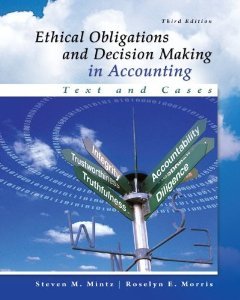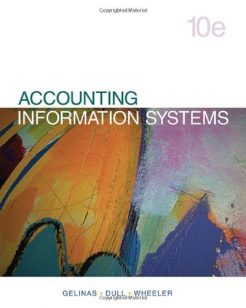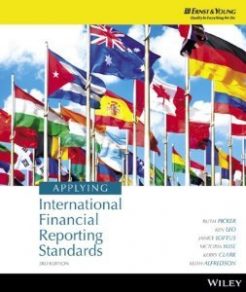Description
Introduction to Financial Accounting, 11e (Horngren)
Chapter 1 Accounting: The Language of Business
Learning Objective 1.1 Questions
1) The primary purpose of financial accounting is to
A) supply information for external users’ decision making.
B) provide data for internal users’ decision making.
C) produce data for income taxes.
D) create an audit report.
E) organize the data for management.
Answer: A
Diff: 1
Objective: L.O. 1-1
2) Footnotes are
A) included in the audit report.
B) an integral part of financial statement information.
C) an appendix to the letter from corporate management.
D) at the bottom of the report of the independent auditors.
E) explanatory information in the statement of management’s responsibility for preparation of financial statements.
Answer: B
Diff: 2
Objective: L.O. 1-1
3) Accountants analyze and record
A) economic events.
B) costs.
C) revenues.
D) financial statements.
E) creditor statements.
Answer: A
Diff: 1
Objective: L.O. 1-1
4) Annual reports include all, but which of the following?
A) A letter from corporate management
B) Footnotes that explain many elements of the financial statements in more detail
C) The report of the independent registered public accounting firm (auditors)
D) Statements by both management and auditors on the company’s internal controls
E) The company’s handbook for new employees
Answer: E
Diff: 2
Objective: L.O. 1-1
5) The accountant at Forgum Corporation is asked to prepare the financial statements for the month of July. Which financial statement will he NOT prepare?
A) Balance sheet
B) Income statement
C) Statement of earnings and taxation
D) Statement of cash flows
E) Statement of stockholders’ equity
Answer: C
Diff: 1
Objective: L.O. 1-1
6) Which of the following would be classified as external users of financial statements?
A) Creditors of the organization and the Internal Revenue Service
B) Stockholders and the CFO of the organization
C) Management of the organization and the audit firm
D) Management of the organization and SEC
E) Stockholders and middle managers of the organization
Answer: A
Diff: 2
Objective: L.O. 1-1
7) Which of the following individuals are most interested in management accounting information for Dotty Industries?
A) Bankers who loan money to Dotty Industries
B) The IRS, who Dotty Industries pays taxes to
C) Stockholders who buy stock in Dotty Industries
D) Management who work for Dotty Industries
E) Suppliers who sell goods to Dotty Industries
Answer: D
Diff: 2
Objective: L.O. 1-1
8) The governmental agency that regulates the stock market and the financial reporting of firms that trade in the market is the
A) Financial Accounting Standards Board.
B) Internal Revenue Service.
C) Public Company Accounting Oversight Board.
D) Securities and Exchange Commission.
E) Generally Accepted Accounting Board.
Answer: D
Diff: 1
Objective: L.O. 1-1
9) Accounting does not provide information that is useful in making decisions that have economic consequences.
Answer: FALSE
Diff: 2
Objective: L.O. 1-1
10) Because officials in federal, state, and local governments are not in the business of making a profit, they do not need an understanding of accounting.
Answer: FALSE
Diff: 2
Objective: L.O. 1-1
11) Financial accounting serves external decision makers, such as suppliers, banks, government agencies, and stockholders.
Answer: TRUE
Diff: 1
Objective: L.O. 1-1
12) Management accounting serves internal decision makers, such as top executives and department heads.
Answer: TRUE
Diff: 1
Objective: L.O. 1-1
13) Managerial accounting serves external users while financial accounting serves internal users.
Answer: FALSE
Diff: 2
Objective: L.O. 1-1
14) The annual report is a document prepared by the board of directors and distributed to current and potential investors.
Answer: FALSE
Diff: 1
Objective: L.O. 1-1
15) It is against SEC regulations to promote the corporation in the annual report.
Answer: FALSE
Diff: 1
Objective: L.O. 1-1
16) Describe the differences between financial accounting and management accounting.
Answer: Financial accounting focuses on the specific needs of decision makers external to the organization such as stockholders, suppliers, banks, and government agencies. Management accounting serves internal decision makers, such as top executives, department heads, college deans, hospital administrators, and people at other management levels within an organization. The two fields of accounting share many of the same procedures for analyzing and recording the effects of individual transactions.
Diff: 2
Objective: L.O. 1-1
Learning Objective 1.2 Questions
1) A liability that results from a purchase of goods or services on open account is referred to as a(n)
A) accounts receivable.
B) notes payable.
C) accounts payable.
D) notes receivable.
E) capital stock.
Answer: C
Diff: 1
Objective: L.O. 1-2
2) Which of the following statements is true?
A) Owners’ equities are economic sacrifices after deducting liabilities.
B) Assets are expected to benefit no one.
C) Liabilities are future cash inflows.
D) Assets are always the sum of liabilities and owners’ equities.
E) Owners’ equities have priority over liabilities for assets upon liquidation.
Answer: D
Diff: 1
Objective: L.O. 1-2
3) The accounting equation can be stated as which of the following?
A) Assets – liabilities = owners’ equity
B) Assets + liabilities = owners’ equity
C) Liabilities + assets = owners’ equity
D) Owners’ equity + assets = liabilities
E) Liabilities – owners’ equity = assets
Answer: A
Diff: 2
Objective: L.O. 1-2
4) Which of the following describes a liability?
A) Future economic benefit
B) Economic obligations to creditors
C) Paid-in capital
D) Investment by owners
E) Present value of customer future payments
Answer: B
Diff: 2
Objective: L.O. 1-2
5) Notes Payable are classified as
A) equity.
B) assets.
C) owner investments.
D) liabilities.
E) expenses.
Answer: D
Diff: 2
Objective: L.O. 1-2
6) Income taxes owed to the federal government would be classified as a(n)
A) liability on the balance sheet.
B) asset on the balance sheet.
C) liability on the statement of cash flows.
D) equity on the balance sheet.
E) They would not appear on a financial statement.
Answer: A
Diff: 2
Objective: L.O. 1-2
7) An example of stockholders’ equity is
A) accounts payable.
B) accounts receivable.
C) capital stock.
D) marketable securities.
E) cash and cash equivalents.
Answer: C
Diff: 1
Objective: L.O. 1-2
8) Statement of financial position is another name for the balance sheet.
Answer: TRUE
Diff: 1
Objective: L.O. 1-2
9) Assets and owners’ equity are presented on the right side of the balance sheet.
Answer: FALSE
Diff: 1
Objective: L.O. 1-2
10) The balance sheet equation is assets = liabilities – owner’s equity.
Answer: FALSE
Diff: 1
Objective: L.O. 1-2
11) Liabilities are economic obligations of the organization to outsiders, or claims against its assets by outsiders.
Answer: TRUE
Diff: 2
Objective: L.O. 1-2
12) Accountants use the terms notes payable or notes receivable to describe the existence of promissory notes.
Answer: TRUE
Diff: 1
Objective: L.O. 1-2
13) Examples of assets include cash, inventory, and capital stock.
Answer: FALSE
Diff: 1
Objective: L.O. 1-2
14) Inventory is goods held by a company for the purpose of sale to customers, and is considered a liability on the balance sheet.
Answer: FALSE
Diff: 2
Objective: L.O. 1-2
15) A balance sheet is dated for a period of time, such as “for the year ended December 31, 20X2.”
Answer: FALSE
Diff: 1
Objective: L.O. 1-2
16) Owners’ equity is the residual interest in the organization’s assets after deducting liabilities.
Answer: TRUE
Diff: 1
Objective: L.O. 1-2
17) Long-term debt $ 190
Cash (1)
Total stockholders’ equity (2)
Total liabilities (3)
Accounts receivable 450
Common stock 75
Inventory 375
Accounts payable 575
Property, plant, and equipment 525
Additional stockholders’ equity 650
Other assets 200
Other liabilities (4)
Total assets 2,000
Using the balance sheet equation as a starting point, determine the missing amounts: (1), (2), (3), and (4) above.
Answer:
(1) $2,000 – $450 – $375 – $525 – $200 = $450
(2) $75 + $650 = $725
(3) $2,000 – $725 = $1275
(4) $1,275 – $575 – $190 = $510
Diff: 2
Objective: L.O. 1-2
18) What is the purpose of a balance sheet?
Answer: A balance sheet shows the financial position of an entity at a point in time. The accounting equation is represented in the balance sheet. The balance sheet reports a company’s assets, liabilities and owners’ equity.
Diff: 2
Objective: L.O. 1-2
Learning Objective 1.3 Questions
1) An entity
A) is a separate economic unit.
B) allows a section of an organization to be a separate economic unit.
C) helps accountants relate events to a defined area of accounting.
D) All of the above
E) None of the above
Answer: D
Diff: 2
Objective: L.O. 1-3
2) If liabilities increase by $10,000 during a given period and stockholders’ equity decreases by $6,000 during the same period, assets must have
A) increased by $16,000.
B) increased by $4,000.
C) decreased by $4,000.
D) decreased by $16,000.
E) This cannot be determined with the given information.
Answer: B
Diff: 3
Objective: L.O. 1-3
3) A transaction
A) affects the financial position of an entity.
B) maintains the equality of the balance sheet equation.
C) affects the cash position of an entity.
D) will always change values on the income statement.
E) both A and B
Answer: E
Diff: 2
Objective: L.O. 1-3
4) Surround Sound, LLC owned land originally costing $33,000. A real estate agent appraised the land and stated that it is now worth $38,000. Surround Sound, LLC should
A) increase the land account by $5,000 and increase the capital stock account by $5,000.
B) increase the land account by $5,000 and increase the cash account by $5,000.
C) increase the land account by $5,000 and increase the paid-in capital in excess of par account by $5,000.
D) There is no effect from the increase in the value of the land on the accounts of Surround Sound, LLC.
E) increase the land account and the investment account.
Answer: D
Diff: 2
Objective: L.O. 1-3
5) Which of the following statements is false?
A) If you increase an asset account, you may increase a liability account.
B) If you increase an asset account, you may decrease an asset account.
C) If you decrease an asset account, you may increase an owners’ equity account.
D) If you decrease an asset account, you may decrease an owners’ equity account.
E) If you increase an asset account, you may increase an owners’ equity account.
Answer: C
Diff: 2
Objective: L.O. 1-3
6) Mexland Company, acquired land costing $25,000. Mexland Company paid $10,000 in cash and issued a short-term note for the balance. The effect of this transaction on Mexland Company, would be to
A) increase the land account by $25,000, decrease the cash account by $10,000, and decrease the balance in the notes payable account by $15,000.
B) increase the land account by $25,000, decrease the cash account by $10,000, and decrease the balance in the notes receivable account by $15,000.
C) increase the land account by $25,000, decrease the cash account by $10,000, and increase the balance in the notes receivable account by $15,000.
D) increase the land account by $10,000 and decrease the cash account by $10,000.
E) increase the land account by $25,000, decrease the cash account by $10,000, and increase the balance in the notes payable account by $15,000.
Answer: E
Diff: 2
Objective: L.O. 1-3
7) Assets amount to $35,000 at the beginning of the period and $40,000 at the end of the period. Liabilities amount to $10,000 at the beginning of the period and $20,000 at the end of the period. What is the amount of the change and the direction of the change in owners’ equity for the period?
A) Increase of $15,000
B) Decrease of $10,000
C) Increase of $5,000
D) Increase of $10,000
E) Decrease of $5,000
Answer: E
Diff: 2
Objective: L.O. 1-3
8) Smith’s Medical Supplies sold unused land at cost, which was $15,000. The buyer paid $6,000 in cash, with the balance to be paid on a note due in 6 months. The effect on Smith’s Medical Supplies is to
A) decrease the land account by $15,000, increase the cash account by $6,000, and increase the balance in the notes payable account by $9,000.
B) decrease the land account by $15,000, increase the cash account by $6,000, and increase the balance in the notes receivable account by $9,000.
C) decrease the land account by $15,000, increase the cash account by $6,000, and decrease the balance in the notes receivable by $9,000.
D) decrease the land account by $6,000 and increase the cash account by $6,000.
E) decrease the land account by $15,000, increase the cash account by $6,000, and decrease the balance in the notes payable account by $9,000.
Answer: B
Diff: 2
Objective: L.O. 1-3
9) Mailers Manufacturing, acquired equipment for $19,000. Mailers Manufacturing, paid $6,000 in cash, with the balance due on a note. The effect of this transaction on Mailers Manufacturing, would be to
A) increase the equipment account by $19,000, decrease the cash account by $6,000 and increase the notes payable account by $13,000.
B) increase the equipment account by $19,000, decrease the cash account by $6,000, and decrease the notes receivable by $13,000.
C) increase the equipment account by $6,000, and decrease the cash account by $6,000.
D) increase the equipment account by $6,000, decrease the cash account by $6,000, and increase the notes payable account by $13,000.
E) increase the equipment account by $19,000, and increase the notes payable account by $6,000.
Answer: A
Diff: 2
Objective: L.O. 1-3
10) Zeus Greek Foods purchased a $21,000 van for use in the business. The company made a $15,000 cash down payment, and signed a note for the balance. The effect of this transaction on Zeus Greek Foods would be to
A) increase the van account by $21,000, decrease the cash account by $15,000, and decrease the notes receivable account by $6,000.
B) increase the van account by $21,000, decrease the cash account by $15,000, and decrease the notes payable account by $6,000.
C) increase the van account by $15,000 and decrease the cash account by $15,000.
D) increase the van account by $21,000, decrease the cash account by $15,000, and increase the notes payable account by $6,000.
E) decrease the van account by $15,000 and increase the cash account by $15,000.
Answer: D
Diff: 2
Objective: L.O. 1-3







Reviews
There are no reviews yet.